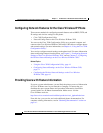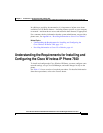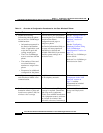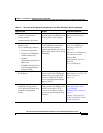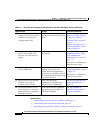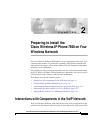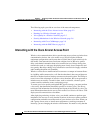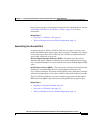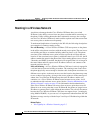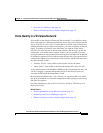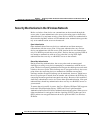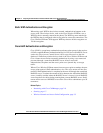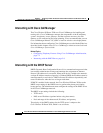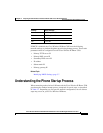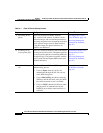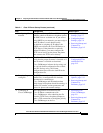
Chapter 2 Preparing to Install the Cisco Wireless IP Phone 7920 on Your Wireless Network
Interactions with Components in the VoIP Network
2-4
Cisco Wireless IP Phone 7920 Administration Guide for Cisco CallManager Release 3.3 or Later
OL-3930-02
Roaming in a Wireless Network
An obvious advantage that the Cisco Wireless IP Phones have over wired
IP Phones is the ability to move from one place to another while conversing on
the phone. Unlike cellular phones that have nationwide coverage, the coverage
area for Cisco Wireless IP Phone is much smaller so phone users must roam from
one access point to another more frequently.
To understand implications of roaming in the WLAN, the following descriptions
are examples of common roaming events:
Pre-call Roaming—A Cisco Wireless IP Phone 7920 user powers on the phone
in the office so the phone associates with the nearby access point. The user leaves
one building and moves to another building where he places a call. The phone
associates with a different access point in order to place the call from the new
location. If the associated access point is within the same Layer 2 VLAN, the IP
address remains the same for the phone. But, if the roaming phone crosses a Layer
3 boundary and DHCP is enabled, the phone will recognize that it is no longer in
the same subnet and will request a new IP address before it can connect to the
network and place the call.
Mid-call Roaming—A Cisco Wireless IP Phone 7920 user is actively engaged in
a call and moves from one building to another. The roaming event occurs when
the phone physically moves enough so that the radio in the phone associates to a
different access point. As the user moves across the location, the phone may roam
to two or three access points. As long as the access points are in the same layer 2
subnet, the Cisco Wireless IP Phone keeps the same IP address and the call
continues. As a Cisco Wireless IP Phone roams between access points, it will
re-authenticate with each new access point. See the “Security Mechanisms in the
Wireless Network” section on page 2-6 for information about authentication.
If the Cisco Wireless IP Phone user moves from an access point that covers IP
Subnet A to an access point that covers IP Subnet B, the phone no longer has an
IP address or gateway that is valid within the new subnet. The call will disconnect
because the Cisco Wireless IP Phone 7920 does not support Layer 3 roaming by
using Mobile IP (MIP). As you can see, it is important to understand how WLAN
IP phone coverage overlays with the Layer 2 and Layer 3 IP addressing within the
IP network.
Related Topics
• Voice Quality in a Wireless Network, page 2-5



